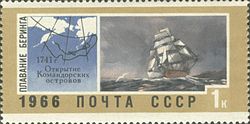Commander Islands
55°00′N 166°24′E / 55.00°N 166.40°E
Commander Islands Командо́рские острова́ ( Aleuts | |
|---|---|
| Area | |
• Total | 1,846 km2 (713 sq mi) |
| Population | |
• 2009 estimate | 613 |
The Commander Islands, Komandorski Islands, or Komandorskie Islands (
In 2005 the Comandorsky State Nature Reserve was nominated for the List of World Heritage Sites in Russia of UNESCO.[1]
Geography

The Commander Islands archipelago consists of 15 islands and is a part of a submarine volcanic ridge extending from
The highest point is Steller's Peak on Bering Island at 755 m (2,477 ft).[1] The highest point on Medny Island is Stenjeger's Peak at 647 m (2,123 ft).
The archipelago lies at similar latitudes to
Climate
The climate is relatively mild for its latitude, and maritime, with 220–240 days of precipitation per year. The cool summers are notoriously foggy. The Köppen climate classification would be classed as Dfc bordering on Cfc and Dfb.
Population

The only permanently inhabited locality is the village of
The village has a school, a satellite tracking station and a dirt airstrip to its south.
The other settlements on the two islands are small villages or scattering of houses:
Natural history


There is no true forest on the Commander Islands. The vegetation is dominated by
Mammals
Due to the high productivity of the Bering Sea shelf and the Pacific slope and their remoteness from human influence, the Commander Islands are marked by a great abundance of marine animal life and a relative paucity of terrestrial organisms.
The neighboring waters provide important feeding, wintering and migrating habitat for many whale species, many of which are threatened or endangered. Among these are: sperm whales, orcas, several species of Minke whales,[5] beaked whales, and porpoises, humpbacks and endangered species such as the North Pacific right whales[3][6] and fin whales.[7]
Bering Island was the only known habitat of
The much less diverse terrestrial fauna includes two distinct, endemic subspecies of Arctic fox, (Alopex lagopus semenovi and A. l. beringensis). Though relatively healthy now, these populations had been significantly depleted in the past due to the fur trade. Most other terrestrial species, including wild reindeer, American mink and rats, have all been introduced to the islands by man.[3]
Birds
Over a million seabirds gather to nest on numerous large colonies along almost all the coastal cliffs. The most common are

The fish fauna in the mountainous, fast running streams is composed primarily of migratory
There are no
History
The Commander Islands received their name from Commander

The 1943 Battle of the Komandorski Islands took place in the open sea about 160 km (100 mi) south of the islands.[14]
See also
- Aleuts in Russia
- Preobrazhenskoye, Kamchatka Oblast, a now-abandoned village on Medny Island.
Notes
- ^ a b c The Commander Islands (Comandorsky State Nature Reserve)
- PMID 12082644.
- ^ JSTOR 1374226.
- ISSN 1545-1542.
- ^ "MPAtlas » Commander Islands". www.mpatlas.org. Retrieved 2019-12-03.
- ^ "Командорский - Японский гладкий кит Eubalaena japonica Lacepede, 1818" [Komandorsky - Japanese right whale Eubalaena japonica Lacepede, 1818]. komandorsky.ru. Retrieved 18 September 2018.
- ^ "Командорский - Финвал (сельдяной кит) Balaenoptera physalus (Linnaeus, 1758)" [Commander - Fin whale (herring whale) Balaenoptera physalus (Linnaeus, 1758)]. komandorsky.ru. Retrieved 18 September 2018.
- .
- ^ "Commander Islands". Greenpeace Russia. Retrieved 2019-12-03.
- JSTOR 4082233.
- . Retrieved 7 January 2024.
- ^ "Commander Islands". BirdLife Data Zone. BirdLife International. 2021. Retrieved 7 February 2021.
- ISBN 0-8047-2181-5.
- ISBN 0-87021-093-9
References
- Richard Ellis, Encyclopedia of the Sea, New York: Alfred A. Knopf, 2001.
- Artyukhin Yu. B. Commander Islands, Petropavlovsk-Kamchatsky, 2005.
External links
- (in Russian) Unofficial website of the Commander Islands
- (in Russian) Photos of the Commander Islands
- Overview of the Kommandorsky Zapovednik
- Details of their current situation
- Commander Islands at the Natural Heritage Protection Fund.
- Island in a Storm
- RI0Z Amateur Radio Expedition to Commander Islands
